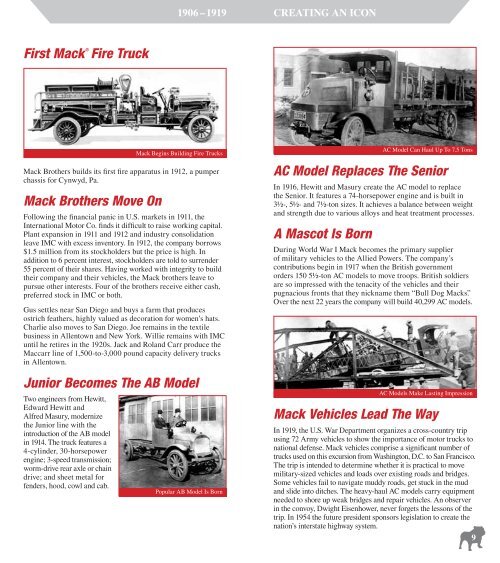Mack - Jeff Widmer
Mack - Jeff Widmer
Mack - Jeff Widmer
Create successful ePaper yourself
Turn your PDF publications into a flip-book with our unique Google optimized e-Paper software.
First <strong>Mack</strong> ®<br />
Fire Truck<br />
<strong>Mack</strong> Brothers builds its first fire apparatus in 1912, a pumper<br />
chassis for Cynwyd, Pa.<br />
<strong>Mack</strong> Brothers Move On<br />
Following the financial panic in U.S. markets in 1911, the<br />
International Motor Co. finds it difficult to raise working capital.<br />
Plant expansion in 1911 and 1912 and industry consolidation<br />
leave IMC with excess inventory. In 1912, the company borrows<br />
$1.5 million from its stockholders but the price is high. In<br />
addition to 6 percent interest, stockholders are told to surrender<br />
55 percent of their shares. Having worked with integrity to build<br />
their company and their vehicles, the <strong>Mack</strong> brothers leave to<br />
pursue other interests. Four of the brothers receive either cash,<br />
preferred stock in IMC or both.<br />
Gus settles near San Diego and buys a farm that produces<br />
ostrich feathers, highly valued as decoration for women’s hats.<br />
Charlie also moves to San Diego. Joe remains in the textile<br />
business in Allentown and New York. Willie remains with IMC<br />
until he retires in the 1920s. Jack and Roland Carr produce the<br />
Maccarr line of 1,500-to-3,000 pound capacity delivery trucks<br />
in Allentown.<br />
Junior Becomes The AB Model<br />
Two engineers from Hewitt,<br />
Edward Hewitt and<br />
Alfred Masury, modernize<br />
the Junior line with the<br />
introduction of the AB model<br />
in 1914. The truck features a<br />
4-cylinder, 30-horsepower<br />
engine; 3-speed transmission;<br />
worm-drive rear axle or chain<br />
drive; and sheet metal for<br />
fenders, hood, cowl and cab.<br />
1906 –1919 CREATING AN ICON<br />
<strong>Mack</strong> Begins Building Fire Trucks<br />
Popular AB Model Is Born<br />
AC Model Replaces The Senior<br />
In 1916, Hewitt and Masury create the AC model to replace<br />
the Senior. It features a 74-horsepower engine and is built in<br />
3½-, 5½- and 7½-ton sizes. It achieves a balance between weight<br />
and strength due to various alloys and heat treatment processes.<br />
A Mascot Is Born<br />
AC Model Can Haul Up To 7.5 Tons<br />
During World War I <strong>Mack</strong> becomes the primary supplier<br />
of military vehicles to the Allied Powers. The company’s<br />
contributions begin in 1917 when the British government<br />
orders 150 5½-ton AC models to move troops. British soldiers<br />
are so impressed with the tenacity of the vehicles and their<br />
pugnacious fronts that they nickname them “Bull Dog <strong>Mack</strong>s”.<br />
Over the next 22 years the company will build 40,299 AC models.<br />
AC Models Make Lasting Impression<br />
<strong>Mack</strong> Vehicles Lead The Way<br />
In 1919, the U.S. War Department organizes a cross-country trip<br />
using 72 Army vehicles to show the importance of motor trucks to<br />
national defense. <strong>Mack</strong> vehicles comprise a significant number of<br />
trucks used on this excursion from Washington, D.C. to San Francisco.<br />
The trip is intended to determine whether it is practical to move<br />
military-sized vehicles and loads over existing roads and bridges.<br />
Some vehicles fail to navigate muddy roads, get stuck in the mud<br />
and slide into ditches. The heavy-haul AC models carry equipment<br />
needed to shore up weak bridges and repair vehicles. An observer<br />
in the convoy, Dwight Eisenhower, never forgets the lessons of the<br />
trip. In 1954 the future president sponsors legislation to create the<br />
nation’s interstate highway system.<br />
9


